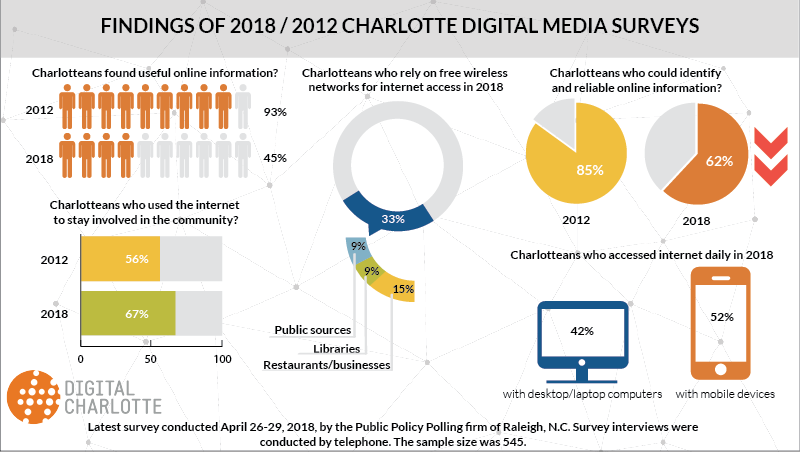Digital inclusion specialists are concluding that Charlotte needs to understand trends in mobile device access, create a winning formula for digital literacy education in West Charlotte, and strengthen the ability of residents to evaluate credible online information.
These projections are preliminary results of two surveys on digital and media literacy, one conducted by Queens University’s James L. Knight School of Communication in 2012, and the other in 2018. Called the Digital and Media Literacy Index, the surveys were designed to measure literacy levels over a number of years, and to determine the impact of work conducted by Digital Charlotte.
At least five key findings emerge from comparing 2018 survey results to 2012.
- Between 2012 and 2018, there were sharp drops in the ability of Charlotte residents to determine what information is accurate and reliable, and what items are most useful. Determining the accuracy of online information dropped by 23 percent, from 85 to 62 percent of respondents. The ability to find useful information dropped even more, by 45 percent, from 93 to 48 percent.
- On a positive note, the surveys indicate a sharp increase in use of the internet for civic engagement. Citizens were 11 percent more likely to say they use the internet to stay involved in the community, moving from 56 percent in 2012 to 67 percent in 2018. They were 15 percent more likely to say they volunteered in their community in 2018.
- West Charlotte remains the area of greatest need in digital and media literacy competencies.
- Charlotte residents are more and more likely to access the internet with mobile devices, including smartphones and tablets. In 2018, 42 percent selected a mobile device as their primary device for internet access, and 10 percent indicated a tablet. In comparison, 42 indicated a desktop or laptop computer. In addition, 74 percent of Charlotte residents connect to the internet daily with mobile devices, in comparison to 65 percent who use a desktop or laptop computer.
- About one-third of Charlotte residents rely on free wireless networks provided by restaurants and businesses (15 percent), libraries (9 percent), or public sources (9 percent).
“These surveys will generate all kinds of discussion in Charlotte, and three issues are especially important,” said Bruce Clark, executive director of Digital Charlotte. “One is that as we move forward, we need to determine what’s going on with mobile device access in Charlotte. When one third of our residents need to rely on some form of free wireless access, that’s an important finding. Is this just a factor of national trends in mobile adoption, or is it related to the expense of broadband?
“Second, people just do not know how to analyze the reliability of online information,” Clark said. “It appears that some actors have become extremely skilled at creating and distributing online ‘fake news.’ People cannot distinguish what is fake and what is not. Beyond digital literacy skills, this tells me we need more focus on media literacy.
“Additionally, we need to create a way to strengthen digital and media literacy specifically in West Charlotte,” Clark said. “This was true in 2012, and it’s still true today. This remains the area of greatest need.”
The lateast surveys were designed in March 2018 and executed during the period April 26-29, 2018, by the Public Policy Polling firm in Raleigh, N.C. Survey interviews were conducted by telephone, and the sample size was 545.
Digital Charlotte and the two surveys were funded in part through a $5.75 million grant to Queens University of Charlotte from the John S. and James L. Knight Foundation, which created the James L. Knight School of Communication in 2010. A central focus of the school is digital inclusion and media literacy, and the Knight School partners with non-profit organizations, small businesses, wide-ranging industry sectors, city and county government, schools, and community leaders. The 2018 and 2012 data and surveys are archived on Digital Charlotte.
Information graphic by Sarah Almusallami.
